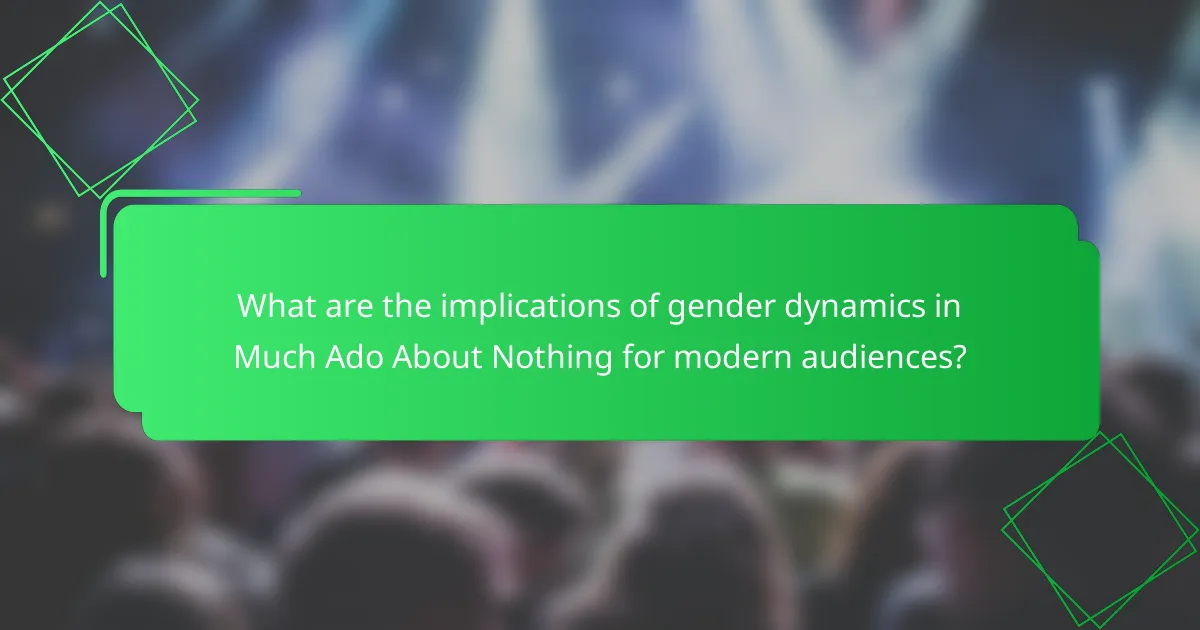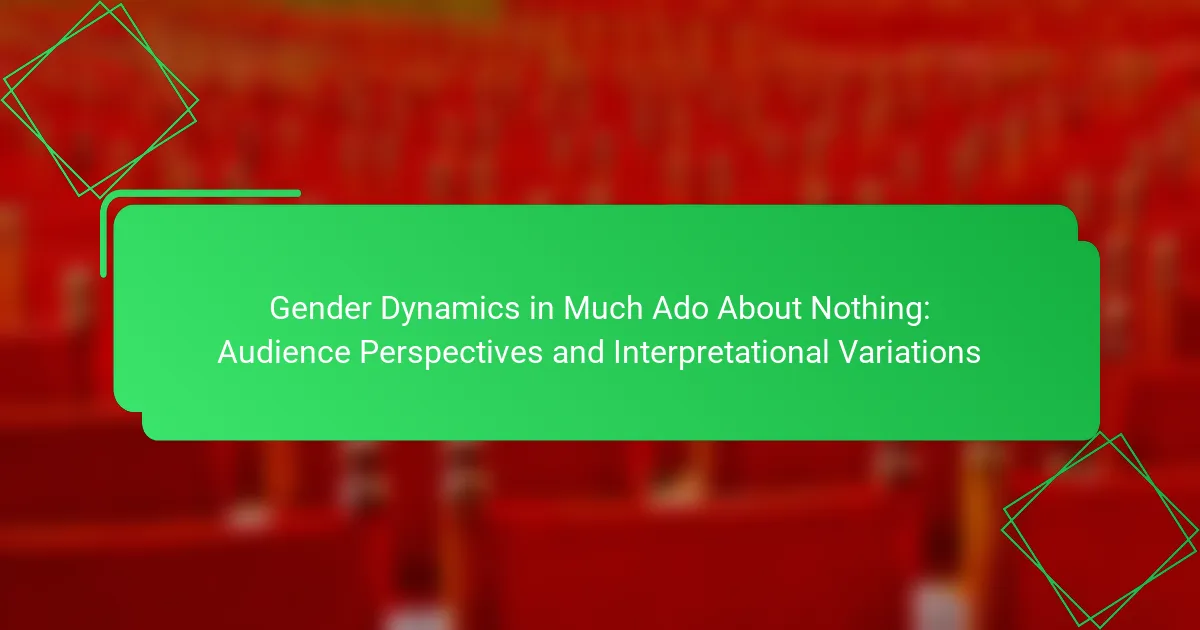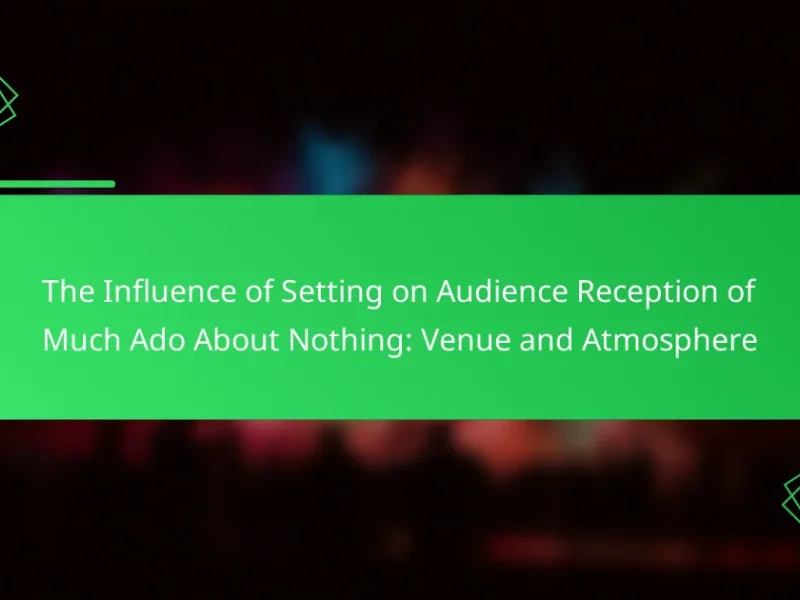
What are the key gender dynamics presented in Much Ado About Nothing?
Key gender dynamics in Much Ado About Nothing include the contrast between male and female roles. Men often exert authority and control, while women navigate societal expectations. Characters like Benedick and Claudio illustrate male dominance in relationships. Conversely, Beatrice challenges traditional gender norms through her wit and independence. The play also depicts the vulnerability of women, as seen in Hero’s public shaming. These dynamics reflect the Elizabethan era’s views on gender. The interactions between characters highlight the complexities of love, honor, and societal pressures. Ultimately, the play critiques and reinforces gender roles, prompting audience reflection on these themes.
How do the characters’ gender roles influence the plot?
Characters’ gender roles significantly influence the plot of “Much Ado About Nothing.” The male characters often embody traditional power dynamics. They control courtship and dictate social interactions. This power imbalance affects the female characters’ agency. For instance, Hero’s fate hinges on male judgment and honor. Beatrice challenges gender norms, providing a counter-narrative. Her wit and independence highlight women’s potential beyond societal expectations. The resolution of the plot relies on these gender dynamics. Ultimately, the interplay of gender roles shapes character relationships and narrative outcomes.
What are the traditional gender roles depicted in the play?
Traditional gender roles depicted in the play include the expectation for men to be authoritative and women to be submissive. Men are portrayed as decision-makers and warriors, showcasing strength and honor. In contrast, women are often relegated to domestic roles, emphasizing their dependence on male figures. Characters like Benedick and Claudio exemplify male dominance through their actions and attitudes. Conversely, Beatrice and Hero represent the societal pressures placed on women to conform to ideals of chastity and obedience. This dynamic reflects the Elizabethan era’s patriarchal values. The play ultimately critiques these roles by presenting strong female characters who challenge societal norms.
How do these roles affect character interactions and relationships?
Roles in “Much Ado About Nothing” significantly influence character interactions and relationships. Gender roles dictate expectations for behavior and communication. For example, male characters often exhibit dominance and assertiveness. This affects their interactions with female characters, who may be expected to be submissive or nurturing. The contrast creates tension and conflict, particularly in relationships like that of Beatrice and Benedick. Their banter showcases a subversion of traditional roles, leading to a more complex dynamic. Additionally, the societal expectations surrounding honor and reputation shape how characters respond to each other. For instance, Claudio’s actions towards Hero are driven by societal pressures, impacting their relationship profoundly. Overall, the roles established by gender dynamics create a framework that dictates character behavior and influences relational outcomes throughout the play.
What perspectives do audiences hold regarding gender dynamics in the play?
Audiences hold diverse perspectives regarding gender dynamics in the play. Some view the interactions between male and female characters as reflective of traditional gender roles. Others interpret the play as a critique of these roles, highlighting the strength and agency of female characters like Beatrice. Additionally, audiences may recognize the comedic elements as a means to explore serious themes of power and control in relationships. The contrast between male bravado and female wit often sparks discussions about societal expectations. Overall, interpretations vary based on cultural context and personal experiences, contributing to rich dialogue about gender in the play.
How do historical contexts shape audience interpretations?
Historical contexts shape audience interpretations by influencing the cultural lens through which a text is viewed. Different eras bring distinct societal norms, values, and expectations. For example, the Elizabethan era had rigid gender roles that affected perceptions of characters like Beatrice and Benedick. Audiences in modern times may interpret their interactions differently, reflecting contemporary views on gender equality. Historical events and movements also play a significant role. The feminist movement, for instance, has led to reevaluations of female characters in literature. Therefore, the historical background provides a framework that guides audience understanding and emotional responses to the narrative.
What modern perspectives challenge traditional views of gender in the play?
Modern perspectives challenge traditional views of gender in “Much Ado About Nothing” by emphasizing fluidity and equality. Contemporary interpretations often highlight the strength and agency of female characters like Beatrice. They argue that her wit and independence subvert conventional gender roles. Additionally, modern readings may explore how male characters exhibit vulnerability, contradicting stereotypes of masculinity. These perspectives advocate for a more nuanced understanding of gender dynamics. Scholars have noted that such interpretations reflect broader societal shifts towards gender equality. They encourage audiences to reconsider the implications of the characters’ actions and relationships. This approach aligns with current feminist theories that question binary gender constructs.

How do interpretational variations impact the understanding of gender dynamics?
Interpretational variations significantly impact the understanding of gender dynamics. Different interpretations can lead to diverse perceptions of characters’ roles and relationships. For instance, a feminist reading of “Much Ado About Nothing” may emphasize female agency. This contrasts with a traditional interpretation that may reinforce patriarchal views. Audience perspectives shape how gender interactions are understood. Various cultural contexts influence these interpretations. Studies show that interpretations can alter the perceived power dynamics between genders. Such variations highlight the complexity of gender roles in literature. Ultimately, they reveal that gender dynamics are not fixed but subject to change based on interpretation.
What factors contribute to differing interpretations among audiences?
Differing interpretations among audiences are influenced by individual experiences and cultural backgrounds. Each audience member brings unique perspectives shaped by their personal histories. Social context also plays a significant role in how content is perceived. Factors such as age, gender, and education can affect interpretation. Emotional responses to themes and characters further contribute to varied understandings. Additionally, the medium of presentation can alter audience reception. For example, live theater may evoke different reactions compared to film adaptations. The interplay of these factors creates a rich tapestry of interpretations.
How does cultural background influence interpretation?
Cultural background significantly influences interpretation by shaping individuals’ values and beliefs. These values and beliefs inform how people perceive and understand texts. For instance, interpretations of humor or conflict may vary based on cultural norms. In “Much Ado About Nothing,” different audiences may interpret Beatrice’s assertiveness through their cultural lens. Research shows that cultural context affects emotional responses and character motivations. A study by Matsumoto and Juang highlights how cultural frameworks guide interpretation of social interactions. Thus, cultural background plays a crucial role in shaping audience perspectives and interpretational variations.
What role does personal experience play in audience perception?
Personal experience significantly shapes audience perception. Individual backgrounds influence how people interpret themes and characters. For instance, viewers with personal experiences related to love or betrayal may resonate more deeply with specific scenes. Research shows that emotional engagement enhances understanding and retention of narratives. A study by Green and Brock (2000) highlights that personal relevance can lead to greater empathy towards characters. Therefore, audience members bring unique perspectives that affect their interpretation of the play’s gender dynamics. This interplay between experience and perception is crucial in analyzing audience responses to “Much Ado About Nothing.”
How do adaptations of Much Ado About Nothing reflect gender dynamics?
Adaptations of Much Ado About Nothing reflect gender dynamics by altering character portrayals and relationships. Many adaptations emphasize the power struggle between genders. For instance, modern versions often highlight Beatrice’s assertiveness and independence. This contrasts with traditional portrayals that may depict her as more submissive.
Additionally, adaptations may change Claudio’s actions to critique toxic masculinity. Some productions present his jealousy and aggression as problematic rather than romantic. This shift prompts audiences to question societal norms regarding male behavior.
Furthermore, settings and contexts are updated to resonate with contemporary gender issues. For example, a modern setting can make the themes of consent and agency more relevant. Such adaptations encourage discussions about gender roles and expectations.
Overall, through character development and contextual changes, adaptations of Much Ado About Nothing engage with and reflect evolving gender dynamics in society.
What changes do adaptations make to gender roles and relationships?
Adaptations often modify gender roles and relationships by reinterpreting character dynamics. These changes can reflect contemporary societal values. For example, modern adaptations may empower female characters more than the original text. This can shift traditional power balances between genders. Additionally, adaptations may introduce new relationships or alter existing ones to challenge stereotypes. Historical context often influences these adaptations, making them relevant to current audiences. As a result, adaptations can encourage discussions about gender equality and social norms. This evolution in storytelling highlights changing perceptions of gender in society.
How do these adaptations resonate with contemporary audiences?
Adaptations of “Much Ado About Nothing” resonate with contemporary audiences by addressing modern gender dynamics. These adaptations often highlight themes of consent, empowerment, and gender equality. For instance, characters may be portrayed with greater agency compared to the original text. This shift aligns with current societal values regarding women’s rights and representation. Furthermore, contemporary settings can make the narrative more relatable to today’s viewers. By using modern dialogue and scenarios, adaptations create a bridge between Shakespeare’s era and current issues. Research indicates that audiences respond positively to these relevant themes, enhancing their engagement with the material. Studies show that adaptations reflecting contemporary values can increase audience appreciation and understanding of classic works.

What are the implications of gender dynamics in Much Ado About Nothing for modern audiences?
The implications of gender dynamics in Much Ado About Nothing for modern audiences highlight ongoing issues of gender roles and societal expectations. The play portrays male dominance and female subservience, reflecting historical norms. For instance, characters like Benedick and Claudio exhibit traditional masculine behaviors, such as aggression and control. Conversely, Beatrice challenges these norms through her wit and independence. This contrast resonates with contemporary discussions on gender equality. Modern audiences can draw parallels between the play’s dynamics and current gender issues, such as consent and power imbalances. The portrayal of deception and miscommunication also reflects how societal pressures can distort personal relationships. Overall, Much Ado About Nothing serves as a lens through which modern audiences can examine and critique ongoing gender dynamics.
How can current audiences apply insights from the play to today’s gender discussions?
Current audiences can apply insights from the play to today’s gender discussions by examining the characters’ interactions and societal expectations. The play highlights themes of honor, deception, and gender roles. These themes resonate with contemporary conversations about gender equality and stereotypes. For instance, Beatrice’s assertiveness challenges traditional female roles. This mirrors modern advocacy for women’s empowerment. Additionally, Claudio’s treatment of Hero illustrates harmful behaviors related to consent and trust. Such portrayals can spark discussions on the importance of mutual respect in relationships today. The play serves as a historical reflection that encourages audiences to critique current gender dynamics.
What lessons can be learned about gender equality from the play?
The play highlights the importance of mutual respect in gender relationships. It shows that both men and women can be victims of societal expectations. The character of Beatrice challenges traditional gender roles. She embodies independence and assertiveness, promoting equality. Claudio’s treatment of Hero reflects the consequences of misogyny. The play critiques the double standards present in romantic relationships. It teaches that communication is vital for understanding between genders. Ultimately, it advocates for a balance of power in relationships.
How does Much Ado About Nothing encourage dialogue on gender issues today?
Much Ado About Nothing encourages dialogue on gender issues today by presenting complex female characters. The play features strong-willed women like Beatrice, who challenge societal norms. This portrayal prompts audiences to reflect on contemporary gender roles. Additionally, the play addresses themes of honor and reputation, particularly regarding women. Such themes resonate with ongoing discussions about gender equality. The characters’ experiences highlight the consequences of societal expectations. This relevance fosters conversations about women’s autonomy and agency today. Thus, the play serves as a catalyst for exploring modern gender dynamics.
What practical insights can be drawn from gender dynamics in Much Ado About Nothing?
Gender dynamics in Much Ado About Nothing reveal significant insights about societal roles and expectations. The play illustrates the tension between male dominance and female agency. Characters like Beatrice challenge traditional gender norms through their wit and independence. Conversely, Hero embodies the expectations of obedience and virtue. This contrast highlights the limited options available to women in the Elizabethan era. The interactions between male and female characters reflect societal power imbalances. Claudio’s public shaming of Hero demonstrates the consequences of these dynamics. Ultimately, the play encourages audiences to reflect on evolving gender roles. Such insights remain relevant in contemporary discussions about gender equality.
How can understanding these dynamics enhance appreciation of the play?
Understanding gender dynamics in “Much Ado About Nothing” enhances appreciation of the play by revealing underlying themes and character motivations. These dynamics illustrate societal expectations and power relations between genders. For instance, the contrast between Beatrice and Hero highlights different responses to patriarchal norms. Beatrice’s assertiveness challenges traditional female roles, while Hero embodies the submissive ideal. This contrast invites audiences to reflect on the implications of gender roles in both the play and contemporary society. Analyzing these dynamics allows for deeper engagement with the text. It encourages viewers to question the relevance of these themes today, thereby enriching their overall experience of the play.
What strategies can audiences use to engage critically with gender themes in literature?
Audiences can engage critically with gender themes in literature by analyzing character roles and relationships. This involves examining how male and female characters are portrayed. Audiences should also consider the historical context of the work. Understanding the societal norms at the time of writing can reveal deeper meanings. Additionally, readers can reflect on their own biases and perspectives. This self-reflection can enhance their understanding of gender dynamics. Engaging with secondary sources, like critical essays, can provide varied interpretations. Lastly, discussing the text with others can open new viewpoints. These strategies foster a more nuanced understanding of gender themes in literature.
Gender dynamics in Much Ado About Nothing serve as the focal point of this article, exploring how male and female roles are portrayed and interpreted. Key themes include traditional gender roles, the influence of societal expectations on character interactions, and the implications for modern audiences. The article examines diverse audience perspectives and interpretational variations, highlighting how historical contexts shape understanding of gender dynamics. Additionally, it discusses how adaptations of the play reflect evolving views on gender equality and encourage critical dialogue about contemporary issues. Insights drawn from these dynamics emphasize the importance of mutual respect and communication in gender relationships.


